AMD Radeon RX 560 4GB Review: 1080p Gaming On The Cheap
Why you can trust Tom's Hardware
Cooling & Noise
Thermal Solution
Asus’ cooler is quite simple. It consists of an aluminum body with fins, which is made using continuous casting. Below it, there's a separate sink for the GPU’s VRM. Meanwhile, the memory VRM doesn't receive any cooling.
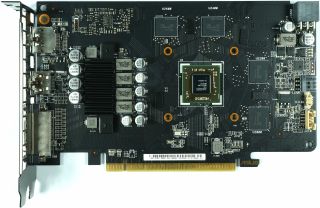
| Cooling Solution Overview | |
|---|---|
| Type of Cooler | Air cooling |
| Heat Sink | Aluminum; two partially-flattened, pressed-in heat pipes |
| Cooling Fins | Aluminum block; continuous casting |
| Heat Pipes | 2x 6mm, nickel-plated |
| VRM Cooling | Only via separate (small) sinkCooling for MOSFETs-only |
| RAM Cooling | None; indirect via fan airflow |
| Fan | 2x 7.5cm fan assembly11 rotor bladesControlled; semi-passive |
| Backplate | None |
The big heat sink has wide slits cut through it, allowing air to pass through to the PCB from both sides. Two heat pipes are partially flattened and pressed into the cooler’s body; this is supposed to improve heat transfer from the GPU throughout both sides of the sink.
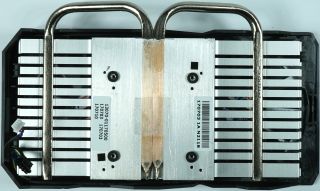
That VRM heat sink we mentioned is more than ample. It doesn't have much headroom for cooling, though. Our highest overclock necessitated a manual fan speed increase to keep the VRM continuously under 100°C.

Fan Speeds & Noise
The fan curves suggest a conservative and noise-optimized profile. There’s no sharp initial impulse to get the fans spinning, and no clear hysteresis. Asus' semi-passive mode is simply a product of the fans’ mechanical/electrical limits and the corresponding voltages. This is what causes the fans to start and stop. It’s a simple, but not very elegant, solution.
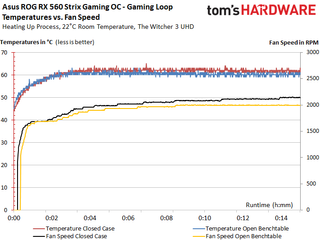
The stress test results are similar., though the fans spin a bit faster due to the card’s higher power consumption.
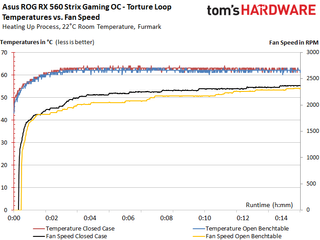
| Fan Speed & Noise Measurements | |
|---|---|
| Fan Speed (Open Benchtable, Maximum) | 2058 RPM |
| Fan Speed (Open Benchtable, Average) | 2050 RPM |
| Fan Speed (Closed Case, Maximum) | 2222 RPM |
| Fan Speed (Closed Case, Average) | 2214 RPM |
| Noise (Air, Maximum) | 41.7 dB(A) |
| Noise (Air, Average) | 41.2 dB(A) |
| Noise (Air, Idle) | 0 dB(A) |
| Noise Characteristics /Subjective Impressions | Almost no low-frequency bearing noisesClearly audible motor noises <1 HzAudible air/airflow noises |
What follows is a high-resolution graph of our measurements that covers the entire frequency spectrum, illustrating our subjective acoustic impressions.
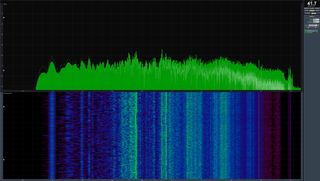
MORE: Best Graphics Cards
MORE: Desktop GPU Performance Hierarchy Table
MORE: All Graphics Content
Current page: Cooling & Noise
Prev Page Temperatures, Clock Rates & Overclocking Next Page ConclusionStay on the Cutting Edge
Join the experts who read Tom's Hardware for the inside track on enthusiast PC tech news — and have for over 25 years. We'll send breaking news and in-depth reviews of CPUs, GPUs, AI, maker hardware and more straight to your inbox.

Award-winning Chinese processor design company Huaxia Chip files for bankruptcy — firm’s CPU, DSP, GPU, and AI processor IPs in limbo

AMD unveils Ryzen Pro 8040- 'Hawk Point' and 8000-series 'Phoenix' processors — AI engines come to the commercial market

Asus ROG Swift PG49WCD 49-inch gaming monitor review: The most colorful OLED yet
-
RomeoReject Cutting it by $20 would make it a $100 card. They'd likely be losing money at that price point.Reply -
firerod1 Reply20235344 said:Cutting it by $20 would make it a $100 card. They'd likely be losing money at that price point.
I meant this card since it’s 1050 ti price while offering 1050 performance. -
cryoburner Reply...we couldn’t wait to see how Radeon RX 560 improved upon it.
Is that why you waited almost half a year to review the card? :3 -
shrapnel_indie Reply20235672 said:...we couldn’t wait to see how Radeon RX 560 improved upon it.
Is that why you waited almost half a year to review the card? :3
Did you read the review?
At the beginning of the conclusion:
The pace at which new hardware hit our lab this summer meant we couldn’t review all of AMD’s Radeon RX 500-series cards consecutively.
-
Wisecracker 4GB on the Radeon RX 560 = "Mining Card"Reply
The minimal arch (even with the extra CUs) can't use 4GB for gaming like the big brother 570. The 2GB RX 560 even trades blows with its 4GB twin, along with the 2GB GTX 1050, at the $110-$120 price point for the gamer bunch.
Leave the RX 560 4GB for the "Entrepreneurial Capitalist" crowd ...
-
bit_user I think your power dissipation for the 1050 Ti is wrong. While I'm sure some OC'd model use more, there are 1050 Ti's with 75 W TDP.Reply
Also, I wish the RX 560 came in a low-profile version, like the RX 460 did (and the GTX 1050 Ti does). This excludes it from certain applications. It's the most raw compute available at that price & power dissipation. -
senzffm123 correct, i got one of those 1050 TI with 75 W TDP in my rig, doesnt have a power connector as well. hell of a card!Reply -
turkey3_scratch My RX 460 I bought for $120 back in the day (well, not that far back). There were some for $90 I remember, too. Seems like just an RX 460. Well, it is basically an RX 460.Reply -
jdwii Man Amd what is up with your GPU division for the first time ever letting Nvidia walk all over you in performance per dollar, performance per watt and overall performance, this is very sad.Reply
Whatever Amd is doing with their architecture and leadership in the GPU division needs to change. I can't even think of a time 2 years ago and before where nvidia ever offered a better value.